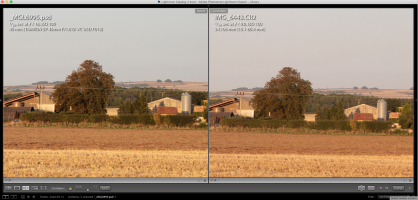you're raising problems that don't really exist.
you can test this with MTF calculations if you want a high MP camera will still capture a truer image than a low MP camera, every, single, time. It will also resolve more with every single lens you own.
diffraction ONLY appears based upon your level of magnification and observer distance. It's an over-exaggerated problem because people look at monitors at 100%. That's not really .. well, real-life presentation of an image.
No, I am specifically NOT looking at the
full size image at 100% and I am specifically referring to real-life presentation of an image. If you do look at 'monitors at 100%' then it is true that the greater output size of the higher mp camera shows a "truer" image even with diffraction over a lower mp one. What I am referring to is viewing am image from the 50 mp 5DS at a realistic output size, say about 42cm / 300dpi long side, so specifically NOT high magnification, when it has suffered from strong diffraction. Here are some examples. My iMac that I use for my photography has died, so these screen grabs are from my 21.5" machine.
The first is the 100% of the full size image, one at f/5, the other at f/16. So this is the comparison where you say above, that you only see it when looking at 100%, and the difference is quite clear to see, as we would expect. All these images are straight ACR conversions from raw with just 80% of 0.3 px sharpening to correct the AA filter.

This was taken on a Manfrotto 058 placed on a hard surface, no wind, no traffic so there is no vibration to give a difference between 1/250th and 1/20th. Live View, 2 sec timer.
I don't have a 20mp full frame camera anymore, but I used a 28mm prime which is same FOV on crop as 45mm on FF, and shot it to give the same DOF as f/16 on the FF shot, so in other words I was using the 19 mp cropped-in 5DS as a crop camera, so f/9. 19 mp at 300 dpi gives an output size of 18" across long size so a
pretty normal viewing size. I then downsampled the FF shot taken at f/16 to compare. I hope that this will show up true when uploaded to CR, but the FF f/16 image has lost it's sparkle - clarity, definition, compared with the 'crop' sensor shot at larger aperture. This clearly shows on an 18" 300 dpi print, and that is most salient point.

Below is the FF image shot at f/5 comparing agains the crop one shot at f/9 as a comparison and to see that the 50mp camera downsized to 19mp has quite an advantage in clarity, as we would expect.

So how can you say this "doesn't exist" ? The diffraction at f/16 has reduced the 5DS's IQ against a ( simulation of ) much cheaper, lower resolution camera significantly. This is why I said "falls off a cliff".
Now I can edit the f/16 shot to improve the clarity, contrast and definition of course. Here's a shot below, compared with the unaltered 19 mp crop shot.

I'm not saying that this is a big issue with the 5DS as I rarely want to use f/16 or over, but it does compromise the IQ, and isn't that why we buy a high mp camera, for IQ ? Or is a 50 mp camera only ever supposed to output 36" images ?
But as the FF sensor becomes even more crammed with pixels this "non" issue will creep down the f stop scale, and once it becomes apparent at everyday apertures like f/8, then I think it's going to be a real "issue".
Just for a laugh here's a comparison between the 5DS at f/16 downsized to the same native output as the old G1X, and the same shot from that 'point and shoot' camera.








